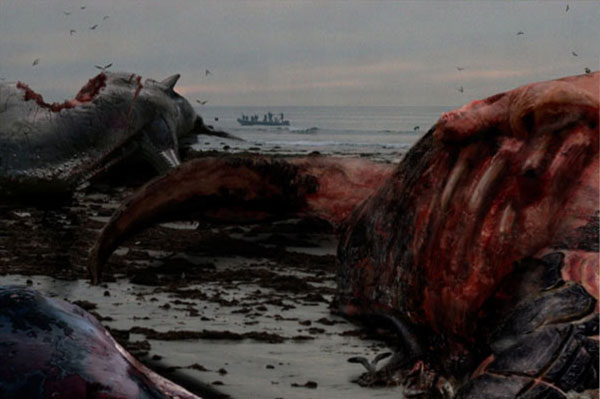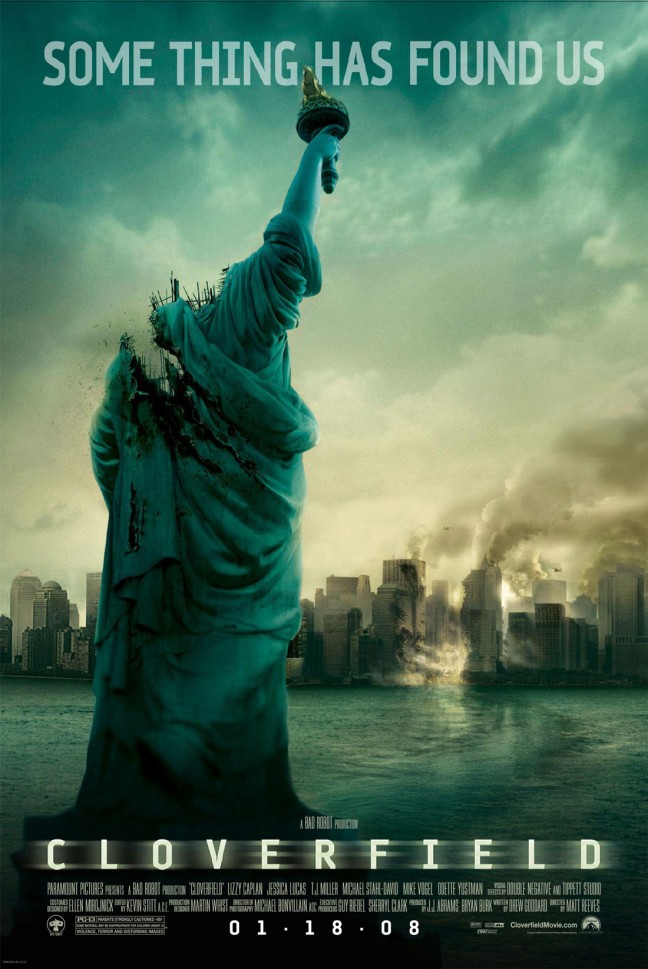By: DC-Wolf
Winding back time to July 2007, to the release of the first Michael Bay-directed Transformers, a mysterious teaser popped up showcasing a camcorder-filmed party that quickly escalated as explosions erupted outside in New York City. As the party-goers run outside to get a better view of what’s going on, a monstrous roar is heard from a distance, followed by the head of Lady Liberty thrown towards them. The footage quickly cuts to black, only revealing that J.J. Abrams is producing it and its release date is January 18, 2008. A bit of a frenzy broke out online as people attempted to deconstruct every little second of the teaser—as well as the roar, trying to figure out what sort of creature is rampaging through the streets of New York City. Though very little information about the film was officially released–other than its title, Cloverfield, the film’s marketing team went to work, pushing out a crazy strong viral marketing campaign for the movie in hopes of creating hype. They did so by creating a sort of puzzle, in the form of several different websites, in order to clue people in to what may have transpired before the Cloverfield’s monster’s rampage through New York City. From Myspace Pages to a Faux-Japanese slushy website, the viral marketing behind the original Cloverfield did a grand job at both immersing people into the film’s universe, while bewildering them at the same time.
Myspace Pages:
( http://cloverfieldclues.blogspot.com/2008/01/myspace-update-slusho-hires-rob_05.html)
Remember Myspace? For those kiddos out there it’s what ancient “emos” (or is the plural form emu?) used as a social media platform where they would customize it to blast Simple Plan music whenever you clicked on their page, as well as allowed them to passively display to their friends how they really feel about them through the “top-10 friends” ranking system on front page (Tom was always #1 for me!)

Okay, back on topic—as strange as it may seem, the Cloverfield marketing team tried to make the film’s protagonists feel like real people by giving each of them their own social media page. It seemed pretty odd that the marketing team would put this amount of effort into fleshing-out their characters outside the film, but at the same time it did offer little hints about the film’s world. Rob Hawkins, played by Michael Stahl-David, posted on his Myspace page that he had recently received a position as the Vice President of Marketing and Promotions for then fictional slushy company, “Slusho,” located in Japan. For those who remembered the original film, this was the reason why he had a goodbye party prior to the monster’s attack. But what is so special about the company Slusho? Well this little fictional company is a famous Easter Egg that has showed up in almost every J.J. Abram film/TV show.

Slusho!

The faux-slushy brand is perhaps one of the biggest Easter Eggs that J.J. Abrams likes integrating into his films and TV Shows. Movies and TV shows that J.J. Abrams was involved with that used this Easter Egg includes: Alias, Lost, Fringe, and even Star Trek. Does this hint at a large-scaled shared universe—or perhaps remnants of an actual failed start-up for a slushy company? Probably neither, but within the wave of viral marketing sites connected to Cloverfield a faux-Japanese website for this brand did pop up. In the slushy’s website it provides a pseudo-history behind the creation of their slushies. According to their oddly intricate pseudo-history the special ingredient used in their slushies derives from a seabed nectar, which was discovered by the underwater petroleum excavation company, Tagruato. Upon this discovery the company’s CEO had some trippy fever dream where his dead mother tells him that this is the “tastiest ingredient ever.” It all sounds like a wonderful story until one visits the Tagruato website…
 Tagruato
Tagruato
( http://www.tagruato.jp/index2.php)

At a glance, the website for the faux-deep sea-drilling company looks fairly legitimate. According to their history page they were founded as a mining company on Kyūshū, Japan, in 1945. They later specialized in exporting engines and large construction vehicles to the West. It was during the 1980’s they hit hard times due to “scandals” and “great losses.” It was in 1989 when the CEO discovered the seabed nectar ingredient that would be used in Slusho that they were able to save their crumbling company. The only problem is that the part of ocean where his company stumbled onto this ingredient seemed to have disturbed something. Although their website’s headline suggests that they had altercations with eco-terrorists, Cloverfield’s final viral site provides a photo that suggest otherwise.
1-18-08
http://www.bannerblog.com.au/news/2007/08/070829_and_mysterious_marketing.php

This website that the Cloverfield marketing team briefly put up provided several snapshots that relate to the film, with a new one added weekly. The first few pictures included several shots of Rob’s goodbye party, but soon the events depicted within each new photo escalated quickly as newly added shots begin to display moments during the monster’s attack. Then in a final snap shot it displays a beach full of partially-eaten, dead whales off the coast of where Tagruato was drilling.

In the end, all of these sites connected in a way. The film’s protagonist, Rob Hawkins, announces on his Faceb—Myspace that he received a new position with the slushy company, Slusho, located in Japan. Slusho happens to be a subsidiary of the sea-drilling company, Tagruato, which appears to have a heavy hand in the monster’s attack, as can also be seen in the film as a ship baring their logo appears to be the first thing destroyed by the monster, which suggests that they caught it and were likely shipping it somewhere. In the end, whether you liked the film or not, there is no denying that the marketing campaign was madly-brilliant (though probably nowhere near as fun as Deadpool’s!). Even if the world-building probably went nowhere, the marketing team certainly did a great job creating these different puzzle pieces in order to help immerse people into the first film’s mythology.

